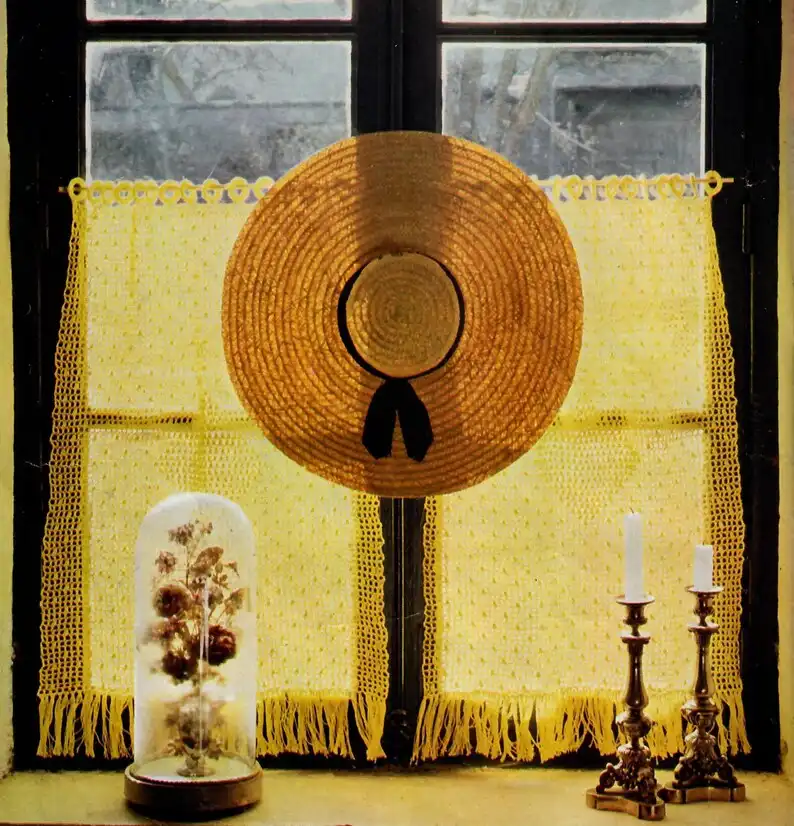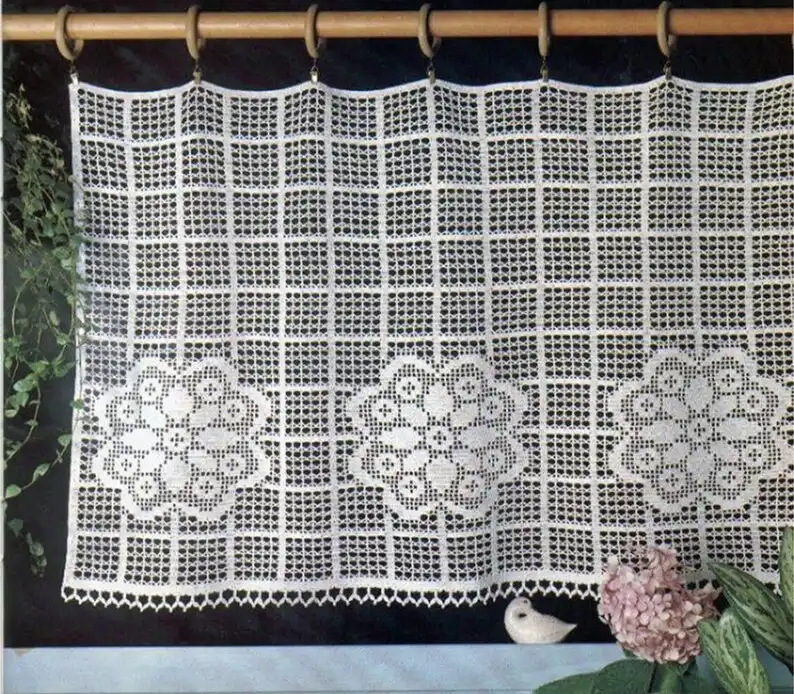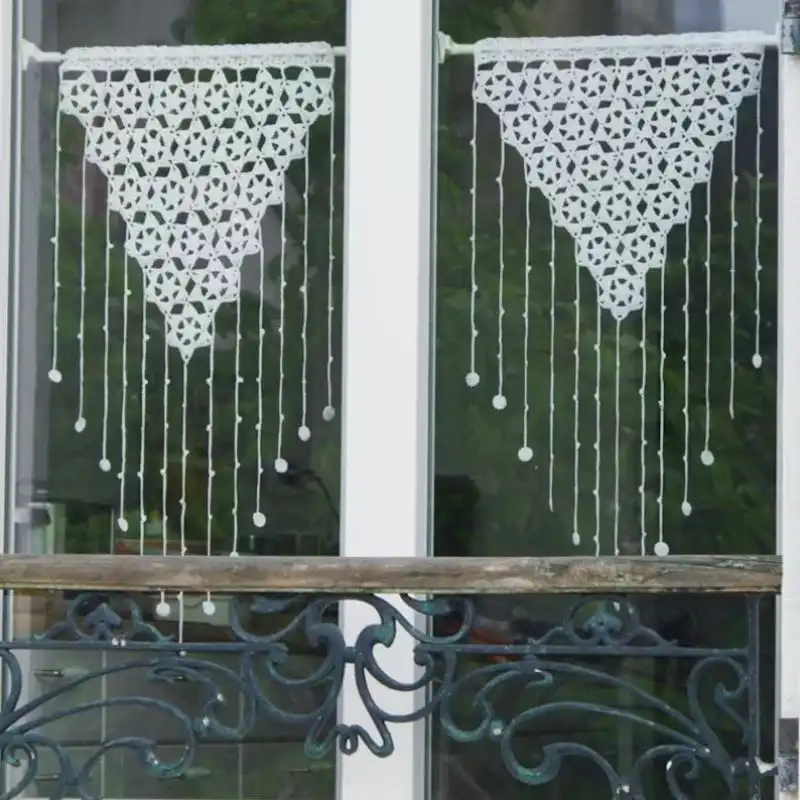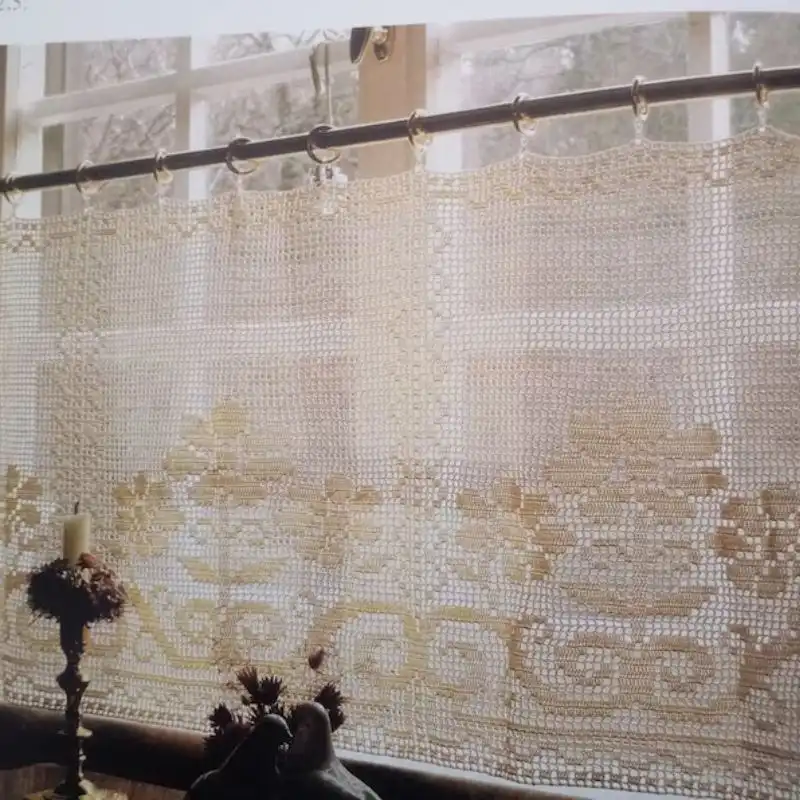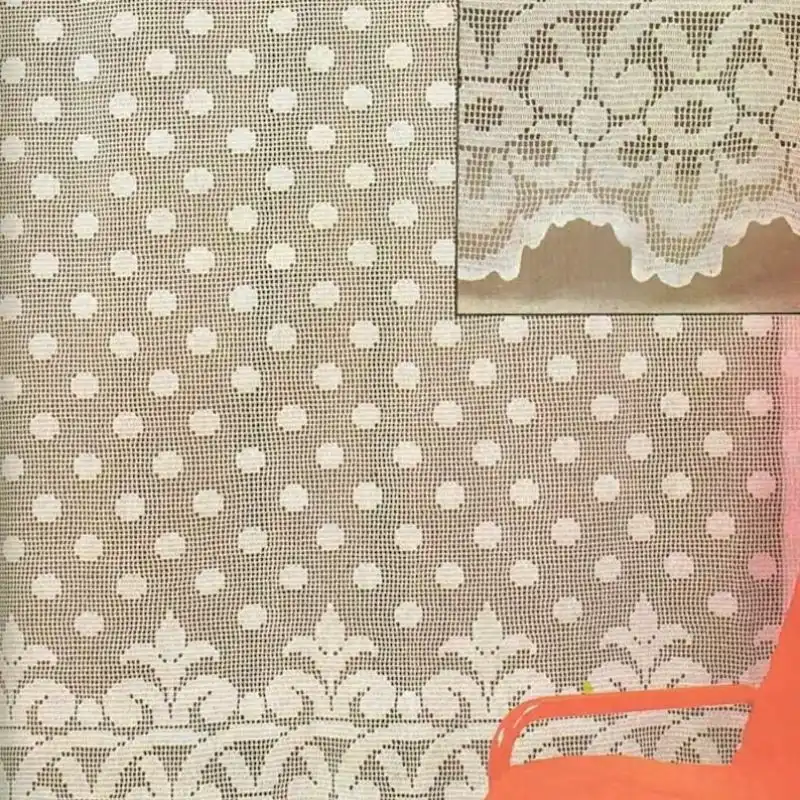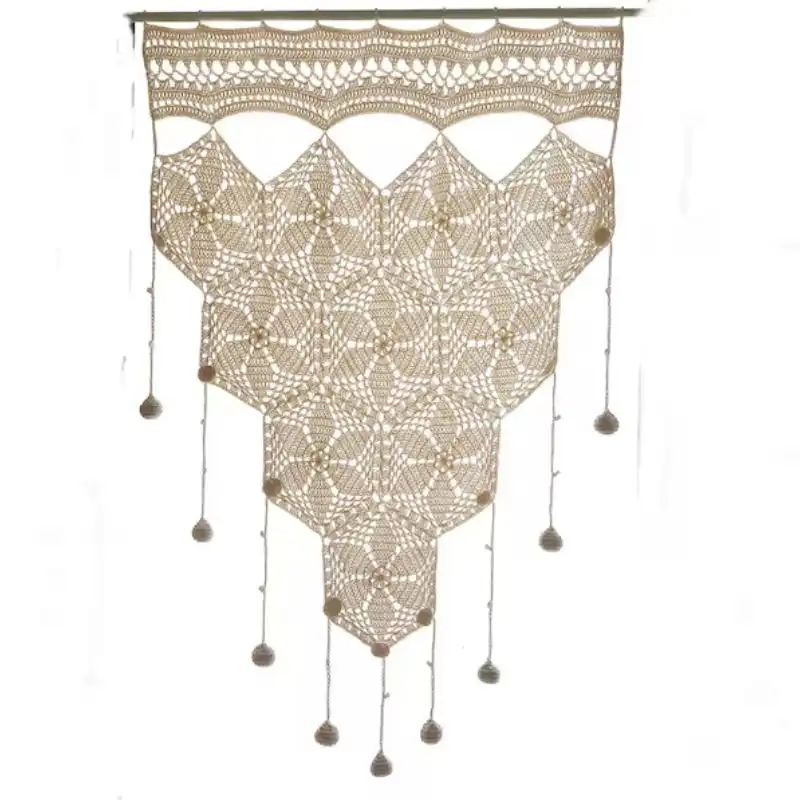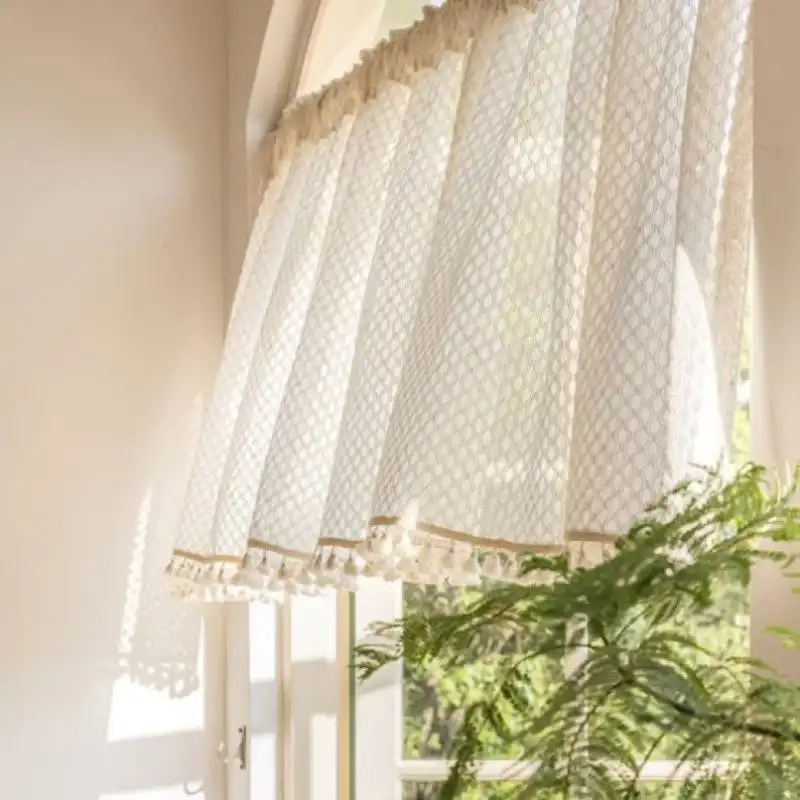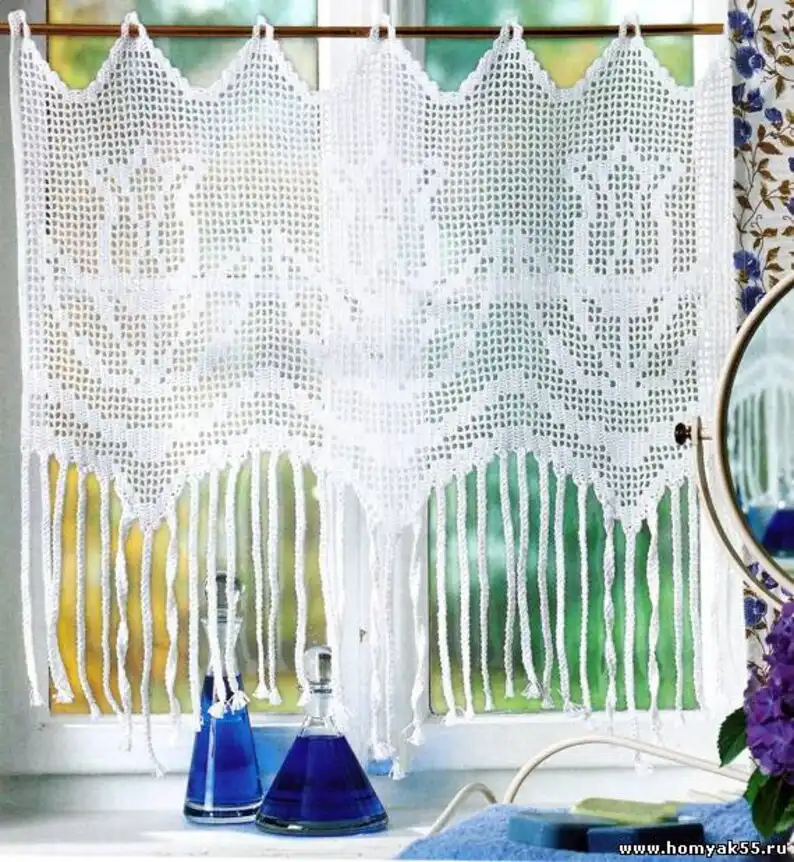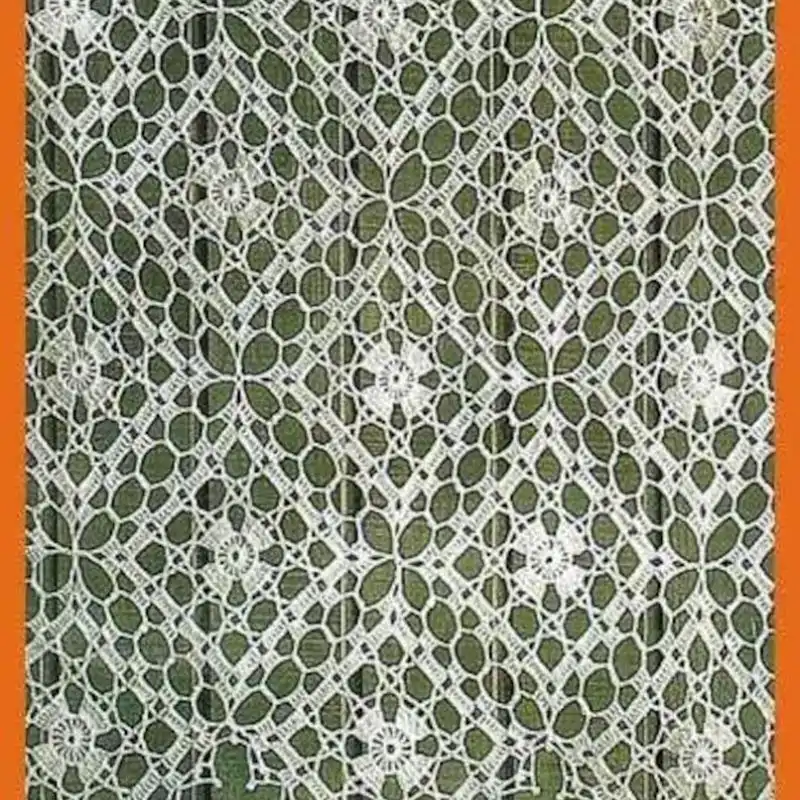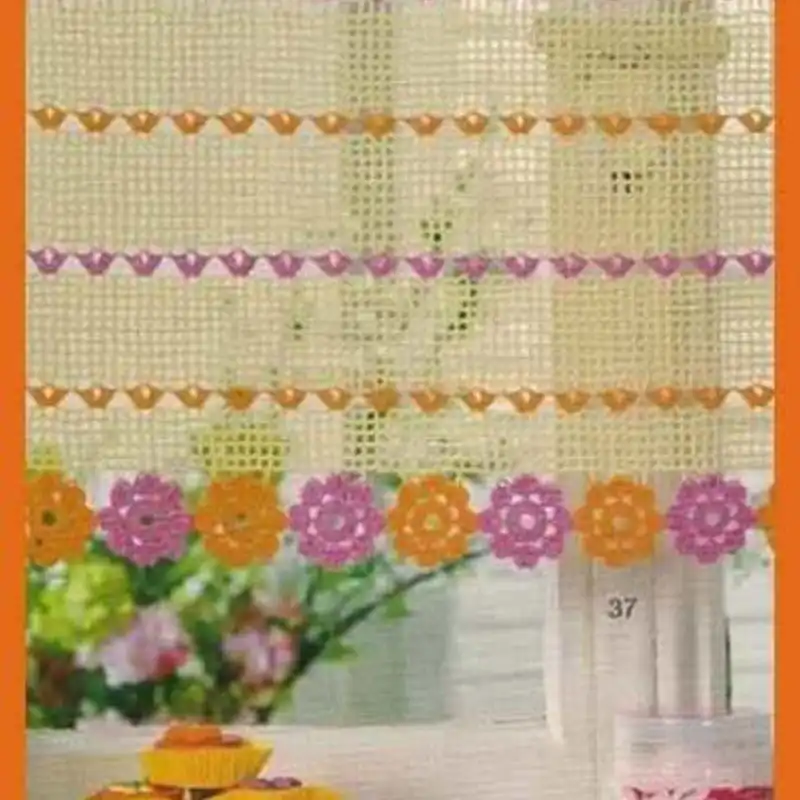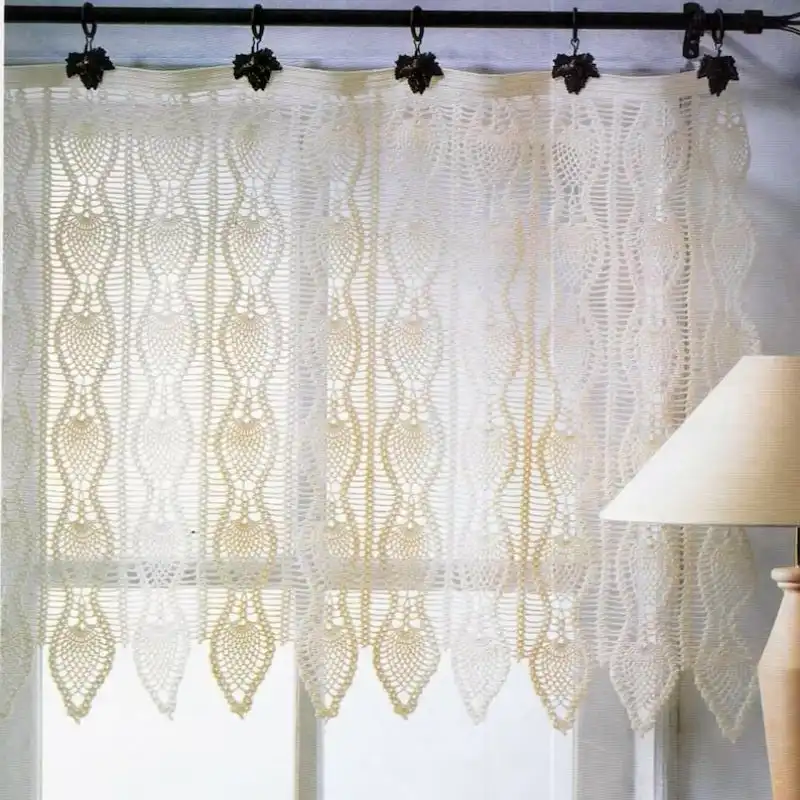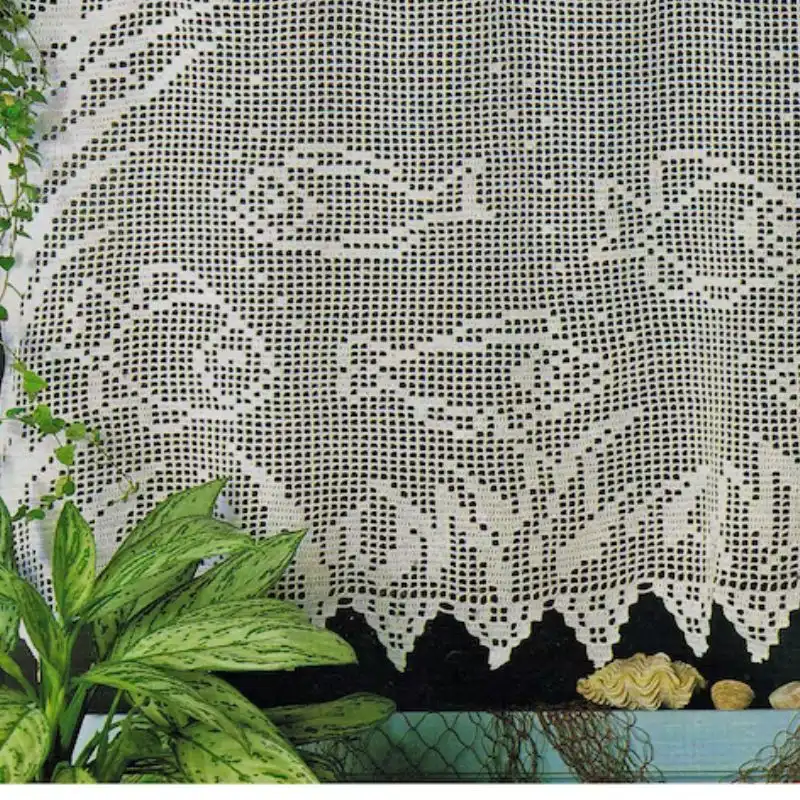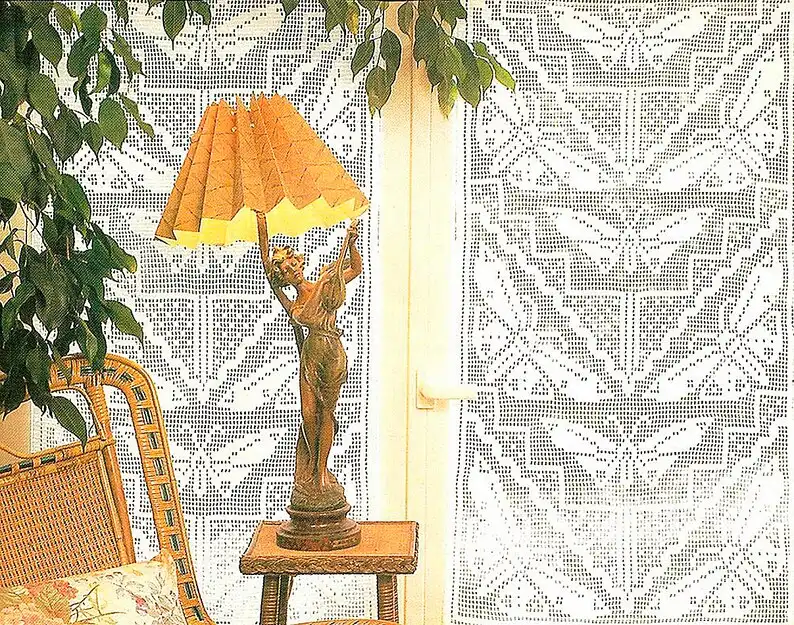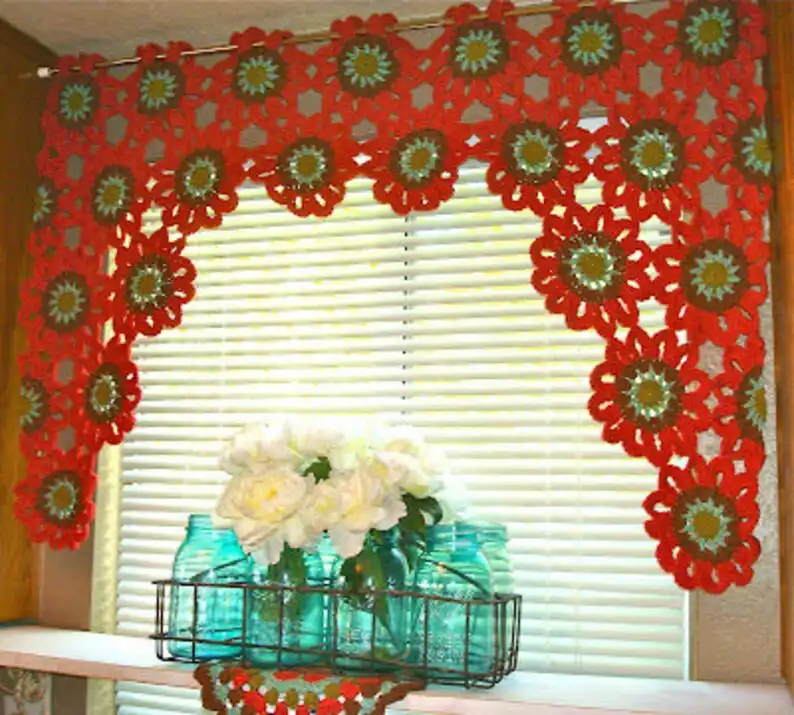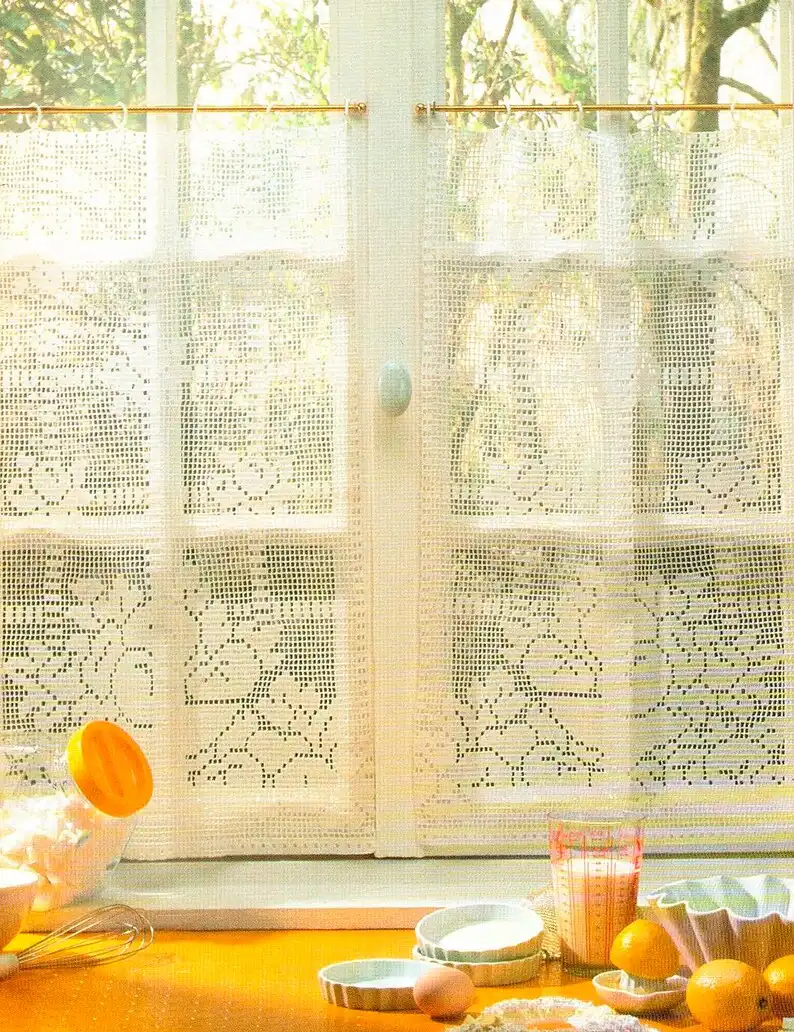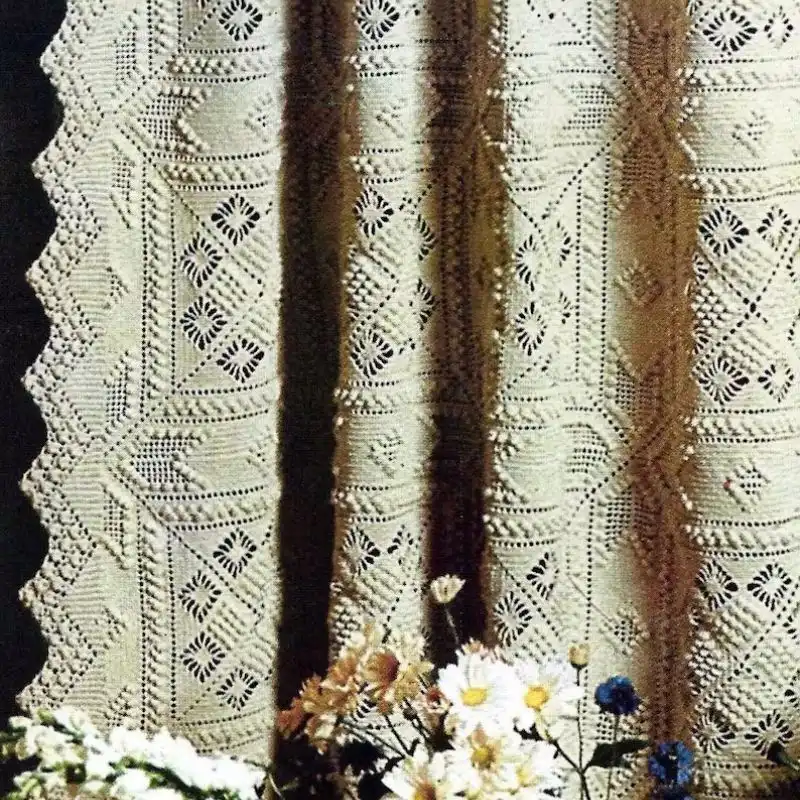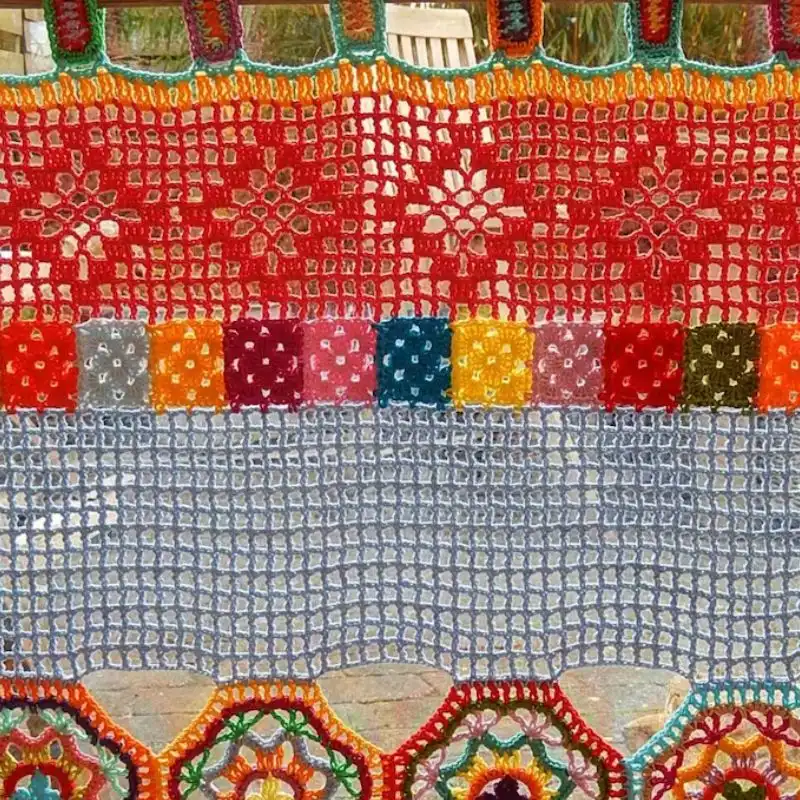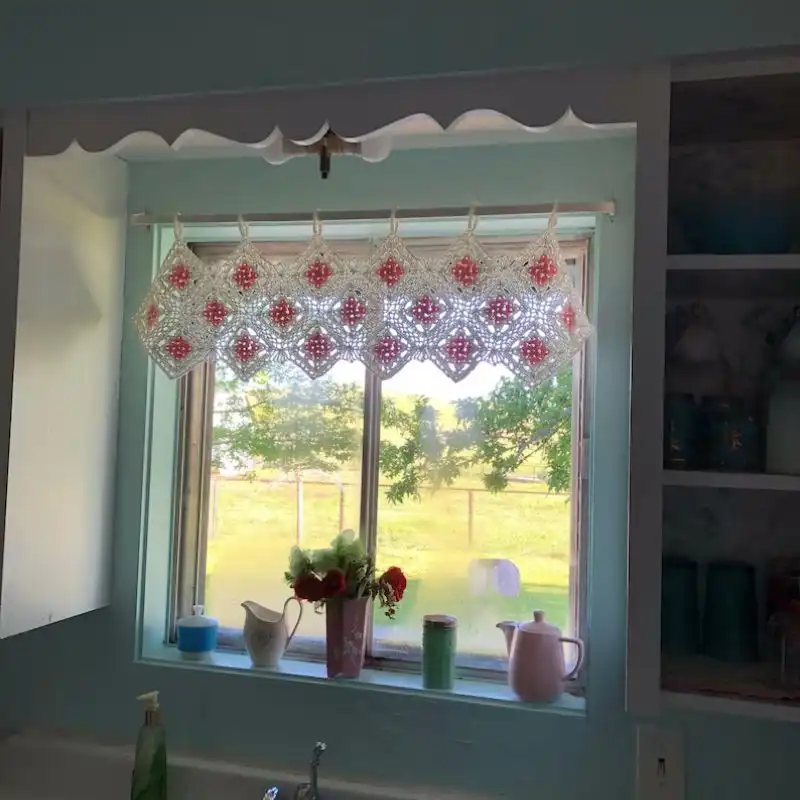Have you ever glanced at your windows and felt they lacked zest? It’s a familiar woe: rooms brimming with personality, yet those drab curtains just hang there, dampening the mood. But what if there’s a whimsical, crafty twist to this tale?

Delight, my fellow yarn enthusiast, for I’ve woven 40 Crochet Patterns For Curtains And Window Treatments to sprinkle some magical charm into your living spaces.
As a seasoned crochet maestro, I’ve spun threads into tales and transformed simple yarns into eye-catching masterpieces.
Now, I invite you on this enchanting journey. Why settle for the ordinary when your windows can flaunt fabulous crochet designs? So, grab those hooks, and let’s thread some fairy tales onto your windows. Magic awaits in every stitch!
The Role Of Curtains And Window Treatments In Interior Design
Crochet curtains and window treatments are pivotal in interior design, offering a blend of functionality and artistry. They regulate light, ensure privacy, and introduce texture, color, and warmth to a room.
Handmade crochet patterns evoke a vintage charm, showcasing intricate craftsmanship that adds depth and character. As focal points, they can transform a mundane space into a cozy haven or a bohemian retreat.
While seamlessly integrating with various design themes, crochet treatments also infuse a personal touch, making the space uniquely curated and nostalgically modern. They’re a testament to the beauty of handcrafted detail in contemporary interiors.
Crochet Curtains And Window Treatments For A Unique And Personalized Space
Crochet curtains and window treatments are like the soulful notes in a room’s symphony. In a world of mass-produced items, these handcrafted gems stand out, providing a window into the artisan’s heart and the homeowner’s unique taste.
Each stitch, pattern, and color choice tells a story, setting the tone for personalized narratives. Unlike off-the-shelf curtains, crochet allows for infinite customization – from matching room hues perfectly to embedding special symbols and motifs.
Think of them as canvases where memories, heritage, and creativity intertwine. Moreover, their tactile allure invites touch, fostering a deeper connection with the living space.
Crochet curtains transform windows from mere glass panes to personalized art installations, reflecting an individual’s journey, aesthetic sense, and desire for a home that truly feels like their own.
RELATED: Easy Crochet Bookmark: Perfect Project for Beginners
Various Stitches To Crochet Curtains
Double Crochet (DC): A fundamental stitch that offers good coverage while still allowing some light to filter through. It’s taller than the single crochet, providing a lovely drape and ideal for curtains that need to hang well.
Shell Stitch: This decorative stitch creates beautiful fan-like patterns. It’s perfect for those wanting a vintage vibe or intricate detailing. The repetitive shells can provide a semi-lacy appearance to curtains, allowing for a gentle diffusion of light.
Filet Crochet: A technique that involves creating pictures or designs using spaces and solid blocks. It’s excellent for curtains when aiming for a delicate pattern or design, like floral motifs or geometric shapes, providing both style and privacy.
Granny Square: Typically used for Afghans, the granny square can be adapted for curtains. Individual squares can be crocheted and joined, allowing for a patchwork-style curtain full of color and charm.
Pineapple Stitch: A classic in the crochet world, this stitch is ornate and offers a regal touch. It’s reminiscent of the old-world charm, making curtains look luxurious with its intricate, lacy design.
V-Stitch: This stitch is both simple and elegant. It involves creating a little “V” pattern, which, when repeated, gives curtains a lacy appearance but with more substance than ultra-delicate patterns. Great for a balance between privacy and light.
Bobble Stitch: The bobble stitch adds delightful texture, Creating tiny “bubbles” on the fabric. It’s ideal for those who want to add a tactile dimension to their curtains, making them visually appealing and touch-friendly.
Glossary Of Crochet Stitches And Techniques
Here’s a glossary of common crochet stitches and techniques:
- Chain (ch): The foundation of most crochet projects, it’s a series of loops linked into one another.
- Single Crochet (sc): A basic stitch creating a tight, dense fabric.
- Double Crochet (DC): A taller stitch than the sc, producing a looser fabric.
- Half Double Crochet (hdc): Sits between the sc and dc in height.
- Treble Crochet (tr): A taller stitch creating an even looser fabric than DC.
- Slip Stitch (sl st): Used to join stitches together without adding height.
- Yarn Over (yo): Wrapping the yarn over the crochet hook.
- Skip (sk): Bypassing a stitch and moving to the next.
- Space (sp): Refers to gaps or holes, often created by chains, where stitches are worked into.
- Turn: Rotate your work to start a new row.
- Join: Connecting yarn, stitches, or motifs using various methods.
- Magic Ring/Circle: A technique to start crocheting in the round with a tight center.
- Increase (inc): Adding more stitches to expand the work.
- Decrease (dec): Removing stitches to narrow the work.
- Front Loop Only (FLO): Crocheting into only the front loop of the stitch below.
- Back Loop Only (BLO): Crocheting into only the back loop of the stitch below.
- Gauge: The number of stitches and rows in a specified size (e.g., 4×4 inches), vital for ensuring correct sizing.
- Blocking: A finishing technique where the crochet piece is wetted, shaped, and allowed to dry, setting its form.
- Fasten Off (FO): Cutting the yarn and securing the last stitch.
- Bobble Stitch: A textured stitch that pops out of the fabric, looking like a little bobble.
- Cluster Stitch: Several stitches are worked into the same stitch or space and joined at the top.
- Puff Stitch: Similar to a bobble but softer and puffier, created by multiple yarn overs.
- Picot: A decorative loop made of a few chain stitches, often used for edging.
- Front Post (FP): Working around the post of a stitch from the front.
- Back Post (BP): Working around the post of a stitch from the back.
- Working in the Round: Crocheting continuously in a circular pattern, often used for hats or motifs.
- Join-as-you-go (JAYG): A method to join crochet motifs while working on them without sewing later.

Understand Crochet Stitches & Techniques
Understanding crochet stitches and techniques begins with familiarizing oneself with the basic symbols and terminology.
Crochet patterns often use abbreviations (e.g., “sc” for single crochet) and may include diagrams with symbols representing each stitch. Start by practicing foundational stitches like chains single, and double crochets.
Once comfortable, progress to more intricate techniques, referencing tutorials or pattern glossaries as guides. Holding the yarn and hook correctly is crucial for consistent tension.
As stitches are mastered, the fabric’s texture and structure become more apparent. Like any skill, mastery comes with practice, patience, and a passion for creating beautiful handcrafted items.
Essential Tools & Materials
Crocheting a curtain can be a delightful project, and having the right tools and supplies can make the process smoother. Here’s a list of essentials you’ll need:
- Yarn: Choose a yarn suitable for your desired curtain weight and look. Lighter yarns (like cotton or lace-weight yarns) will produce a more delicate and airy curtain, while heavier yarns can create a denser, cozier effect.
- Crochet Hooks: The size will depend on the yarn you’re using and your desired stitch tightness. Always refer to the yarn label or your pattern for recommendations.
- Pattern: A detailed crochet curtain pattern can guide you, especially if it’s your first time. It will provide instructions, stitch types, and, often, visual diagrams.
- Yarn Needle: For weaving in ends once you’re finished.
- Scissors: For cutting yarn. A good pair of sharp scissors ensures clean cuts.
- Stitch Markers: These can be very helpful in marking specific points in your pattern or keeping track of stitch counts.
- Measuring Tape: It is essential to ensure that your curtain reaches the desired length and width. It’s also helpful when determining the starting chain length.
- Blocking Boards (optional): If your curtain needs blocking (a process to shape and set the crochet piece) after it’s done, you’ll need a surface to pin it down. Some people use foam boards or specially designed blocking mats.
- Pins (for blocking): These are used to pin your curtain on the blocking board.
- Curtain Rod & Rings or Clips: Depending on your design, you may need a curtain rod to hang your finished piece. Some crochet curtains can be hung directly on the rod, while others require rings or clips.
- Stiffening Agent (optional): If you want your curtain to maintain a particular shape or have a firmer feel, products like fabric stiffeners can be used.
How long should a curtain be?
When it comes to curtain length, there isn’t a one-size-fits-all answer. The ideal length often depends on the room’s style, window height, and desired aesthetic. Here are some standard curtain lengths and their associated design effects:
Sill Length: These curtains just touch the windowsill. They’re typically used for windows where long drapes might be impractical, like kitchen windows. They offer a neat appearance.
Apron Length: Apron-length curtains are often used in rooms where longer curtains might get in the way, such as over a radiator or a storage unit, Extending a few inches below the windowsill.
Floor Length: A popular choice for many living rooms and bedrooms, these curtains end just about a half-inch above the floor. They give a clean, modern look and can make a room seem taller by emphasizing the vertical dimension.
Puddle Length: Puddle-length curtains extend onto the floor from a few inches to a foot, Adding a touch of luxury and drama. This ‘puddling’ effect is reminiscent of classic European interiors and works well in formal settings or with heavier, luxe fabrics.
Café Curtains: These are short curtains that cover only the bottom half of a window. They’re great for spaces where you want light and privacy, such as in a bathroom or kitchen.
Floating: This is a minimalistic look where the curtain barely hangs off the floor, floating about an inch above. It’s a style that’s both modern and avoids any potential for the curtain to drag or get dirty.
Which Yarn Is Best To Crochet Curtain?
Choosing the suitable yarn for crocheting curtains is essential, as it determines the curtain’s appearance, drape, and durability. Here are some yarn options, each with its unique qualities:
Cotton
Pros: It’s durable, holds shape well, and has a natural look. It drapes beautifully and is less likely to stretch out over time. Cotton also allows for easy washing.
Cons: It can be heavier than other yarns, which might affect the curtain’s drape depending on the design.
Linen
Pros: Linen has a rustic charm and gets softer with every wash. It’s strong, breathable, and resists decay.
Cons: It can be stiff initially and might wrinkle easily.
Bamboo
Pros: This yarn is silky, breathable, and has a beautiful sheen. It’s also eco-friendly and offers natural UV protection.
Cons: Bamboo can be slippery to work with and might stretch over time.
Synthetic Yarns (Acrylic, Polyester)
Pros: They’re generally affordable, come in various colors, and resist moth damage. These yarns are also lightweight.
Cons: They might not have the same natural feel as other yarns, and some may not drape as elegantly.
Blends (Cotton-Linen, Cotton-Acrylic)
Pros: Blends combine the best qualities of each yarn type. For instance, a cotton-linen blend might offer the softness of cotton with the durability of linen.
Cons: The characteristics of blends can vary widely, so it’s essential to check the blend ratio and feel the yarn before purchasing.
Lace or Thread Weight Yarns
Pros: Ideal for delicate, lacy curtain designs. They create intricate patterns that allow more light to filter through.
Cons: They’re finer, making them potentially more challenging to work with for beginners.
How Much Yarn Do I Need To Crochet A Curtain?
The amount of yarn needed to crochet a curtain depends on several factors:
- Size of the Curtain: A large floor-to-ceiling curtain will require more yarn than a smaller window dressing.
- Stitch Density: Lacy, openwork patterns consume less yarn than dense, tightly-packed stitches.
- Yarn Thickness: Bulkier yarns cover more space quickly, requiring fewer yards/meters than finer yarns for the same-sized curtain.
- Hook Size: A larger hook yields a looser weave, which can use less yarn than tighter weaves from smaller hooks.
To get an accurate estimate
- Check if your pattern specifies the amount of yarn required.
- If crafting without a pattern, make a swatch (a small sample) of your intended stitch in the desired yarn. Measure the swatch’s dimensions and calculate its area. Then, determine the curtain’s total area and use the swatch as a reference to estimate the total yarn amount.
- Always buy a little extra to account for mistakes or variations in tension.
Is Crocheting A Curtain Beginner Friendly?
From my experience, crocheting a curtain can be beginner-friendly, but it largely depends on the chosen pattern.
Starting with simple stitches and patterns can make the journey less daunting for novices. I began with a basic window valance using only chains and double crochets, and it turned out lovely!
The repetitive nature of curtain patterns can help reinforce basic techniques and boost confidence. However, it’s essential to remain patient and persistent.
Larger projects can feel overwhelming, but breaking them down into smaller sections or rows makes the process more manageable. With determination and practice, any beginner can craft a beautiful crochet curtain!
How To Crochet A Beginner-Friendly Curtain? – Step By Step Instructions
Skill Level
Beginner
Materials
- Cotton yarn (DK weight) – approx. 500-800 yards, depending on window size
- Crochet hook – size H (5.00mm) or size recommended for your yarn
- Scissors
- Yarn needle
- Measuring tape
Stitches Used
- Chain (ch)
- Double Crochet (dc)
Instructions
Measure Your Window: Determine the width and length you want for your curtain.
Start with a Foundation Chain
- Create a slipknot.
- Chain stitches until you’ve reached the desired width of your curtain. Ensure the number of chains is a multiple of 2 for this pattern.
Row 1
Double crochet into the fourth chain from the hook (the first 3 chains count as a double crochet).
Continue to double-crochet into each chain across the row.
Row 2
- Chain 3 (this counts as your first double crochet for the next row).
- Turn your work.
- Double crochet into the second stitch from your hook and each stitch across.
Continue Building Length
Repeat Row 2 until you’ve reached your desired curtain length.
Finish
- Once you’ve achieved the desired length, cut your yarn, leaving a tail of about 6 inches.
- Yarn over and pull through the loop on your hook to fasten off.
- Weave in any loose ends with the yarn needle.
Hanging Your Curtain
- You can slide a curtain rod through the spaces made by the double crochets at the top or use clip-on curtain rings.
Tips
- Always check the curtain’s width and length against your window as you progress to ensure it fits perfectly.
- Feel free to add variations like color stripes or edgings once you are more confident!
RELATED: 25 Amazing Diamond Stitch Crochet Blanket Patterns (With Pictures)
40 Different Crochet Patterns For Curtains And Window Treatments
1. Simple and Airy Valance
The Simple and Airy Valance crochet pattern is perfect for those who prefer a clean and uncluttered look.
It adds a touch of elegance and lightness to your windows, allowing just the right amount of natural light to filter through. The simplicity of this pattern makes it versatile and suitable for various room styles and decors.
2. Basic Crochet Cafe Curtains
These basic crochet cafe curtains are a go-to choice for anyone looking to bring a cozy and homely feel to their kitchen or dining area. The simplicity of the pattern allows you to create curtains that provide privacy while letting in ample daylight.
3. Lace Window Valance Panel Curtain
This pattern is for those who appreciate the delicacy and intricacy of lacework. It creates a beautiful valance that adds a touch of timeless charm to your windows. The lace panel design exudes an air of sophistication, making it ideal for more formal living spaces.
4. Kitchen Curtains
These kitchen curtains are versatile and practical. They are easy to crochet and can be customized to match your kitchen’s color scheme and style. Kitchen curtains are perfect for enhancing the warmth of your culinary space.
5. Filet Curtains
Filet curtains feature openwork patterns, often grid-like, bringing a refined elegance to any room. These curtains allow a play of light and shadow, making them an ideal choice for those who seek a balance between privacy and natural illumination.
6. Farmhouse Kitchen Curtain
These crochet curtains exude rustic charm, making them an excellent choice for creating a farmhouse-style kitchen. They typically feature earthy colors and simple, cozy patterns that reflect the heartwarming atmosphere of a countryside kitchen.
7. Lacy Curtains
Lacy curtains are all about intricate details and a touch of femininity. The delicate patterns create a sense of airiness and refinement, making them suitable for bedrooms and living rooms where a touch of elegance is desired.
8. Trimmed Country Cafe Curtains
For those who appreciate a rustic, country-inspired style, these cafe curtains are adorned with charming trim details. It adds a touch of warmth and character, making it a perfect choice for bringing a welcoming feel to your windows.
9. Art Deco Curtains
These crochet curtains are inspired by the Art Deco era and celebrate vintage glamour. Their geometric patterns and bold designs are perfect for adding a touch of luxury to your space.
10. Beautiful Ticking stripe cafe Curtain
This pattern combines the art of crochet with the timeless charm of ticking stripes. The result is a classic yet stylish curtain that suits various interior designs, from traditional to coastal.
Suggested Yarn: Cotton Blend Yarn
Difficulty Level: Intermediate
Yarn Weight: Medium
Crochet Hook: 4.0 mm
11. Crochet Mesh Cotton Curtain
Ideal for those seeking a fresh and airy atmosphere, this crochet curtain is made from lightweight cotton with mesh-like patterns. It allows air to circulate, adding a light and breezy feel to any room.
12. Country Daisy Trimmed Valance
These charming crochet valances are adorned with daisy motifs, instantly infusing your space with the beauty and simplicity of the countryside. Perfect for creating a cheerful and rustic ambiance.
13. Curtains Valance
Curtains valance, often known simply as valance, is a decorative and functional window treatment typically used with curtains or blinds. Valances are designed to cover the upper part of the window, concealing the curtain rod or hardware and adding an extra layer of style to the window.
14. 1970’s Retro Crochet Curtain
Step back in time with this crochet curtain pattern reminiscent of the 1970s. These curtains will make a statement and evoke nostalgia for a bygone era, Featuring bold and psychedelic designs.
15. Multicolor Curtain crochet pattern
Bright and vibrant, this multicolor crochet curtain pattern is a joyful addition to any room. It’s perfect for adding color and energy to your home decor.
16. Moon And Stars Cafe Curtain
This whimsical design features moon and star motifs, making it an excellent choice for a child’s room or a space where you want to add a touch of wonder and imagination.
17. Vintage Lace Curtains
Vintage lace curtains exude timeless elegance and sophistication. These curtains can transform your windows into works of art, creating an atmosphere of grace and refinement.
18. Intricate Filet curtains
For those who appreciate fine craftsmanship, intricate filet curtains feature highly detailed crochet work, often showcasing intricate designs like florals, geometric patterns, or even scenic depictions.
19. Easy Crochet Curtains
Perfect for beginners, these curtains are designed to be simple, making them an excellent choice for those new to crochet. They offer a fantastic way to enhance home decor with your handmade touch.
20. Cottage Kitchen Style Curtains
These curtains bring the cozy charm of a cottage kitchen to your home. The patterns are typically inspired by the simplicity and warmth of cottage life, creating an inviting atmosphere in your kitchen.
Suggested Yarn: Cotton Blend Yarn
Difficulty Level: Intermediate
Yarn Weight: Light
Crochet Hook: 3.0 mm
21. Cobweb Curtains
Cobweb curtains are genuinely unique, with a design that resembles delicate spiderwebs. It creates an ethereal and slightly eerie atmosphere, making them perfect for Halloween or other themed events.
22. Cafe Curtains
Classic cafe curtains are timeless and perfect for kitchens and breakfast nooks. They are designed to let in plenty of light while providing a touch of privacy.
23. Hexagon Shaped Curtains
Geometric patterns take center stage in these crochet curtains, creating a contemporary and stylish look. The hexagon motifs offer a modern twist to your window coverings.
24. Gentle Breeze Curtain
These curtains are designed to bring your space a light and breezy atmosphere. The openwork patterns allow air to flow through, making them an excellent choice for summer decor.
25. Kitchen Curtain Tulips Pattern
With tulip motifs, these curtains bring floral beauty to your kitchen. They add a touch of nature and a pop of color to your culinary space.
26. Vintage Crochet Curtain From Motifs
This pattern allows you to create a vintage-inspired curtain by joining crochet motifs. The result is a curtain that oozes charm and nostalgia.
27. Openwork Curtain For Kitchen
These curtains are perfect for brightening up your kitchen and adding a touch of lightness and simplicity to the space, Crocheted with openwork stitches.
28. Lace Pineapple Curtains
Pineapple motifs symbolize hospitality and adorn these lace curtains, creating an inviting and tropical atmosphere in your home.
29. Fish Tank Lace Edged Valance
This unique design combines fish tank motifs with lace edging, creating a whimsical and aquatic-inspired valance.
30. Beautiful Lace Butterflies Crochet Curtains
Delicate butterflies take center stage in these lace curtains, adding a sense of enchantment and beauty to your home.
31. Crochet Flower Curtain Motif Pattern
This pattern allows you to enhance your decor with charming crochet flower motifs. These motifs add a touch of nature and grace to your windows.
32. Lace Curtains Granny Circle Motif Door
These curtains exude a cozy and vintage feel. They are a perfect addition to a room with a classic and timeless aesthetic, Created from granny circle motifs.
33. Lacy Cafe Curtain Country Cottage Kitchen Style
These cafe curtains are all about adding a touch of lace and lace-like patterns to your space. They embody the cozy charm of a country cottage kitchen, making your home feel like a retreat.
34. Nordic Star Window Curtain with Valance Pattern
These curtains feature star motifs and a valance for a clean and modern appearance, Drawing inspiration from Nordic design.
35. Blowing Wheat Valance
This unique pattern captures the beauty of wheat blowing in the breeze, creating a simple yet elegant valance that brings a touch of the outdoors to your interior decor.
Suggested Yarn: Cotton Blend Yarn
Difficulty Level: Intermediate
Yarn Weight: Light
Crochet Hook: 3.0 mm
36. Whimsical Birds Valance
With whimsical bird motifs, this valance adds a playful and whimsical touch to your windows, creating a cheerful and lighthearted atmosphere.
37. Crocheted Curtain or Bedspread Pattern
Versatile and multifunctional, this pattern can be used to create both curtains and bedspreads. The intricate crochet work adds an air of craftsmanship and artistry to your space.
38. Boho Curtain
The Boho Curtain pattern embodies the free-spirited and eclectic nature of Bohemian design. It combines colors, textures, and patterns to create a vibrant and artistic curtain.
39. Petals on Point Valance
Unique and eye-catching, this pattern distinctively arranges petal motifs, creating a valance that is artistic and stylish.
40. CottageCore Curtains
Inspired by the CottageCore aesthetic, these curtains exude a sense of comfort, nostalgia, and a connection to nature. They are perfect for creating a cozy and idyllic ambiance in your home.
Tips And Tricks For Perfect Crochet Curtains And Window Treatments
A flawless curtain can elevate the ambiance of any room. Here are some tips and tricks to help you avoid common crochet mistakes and ensure your curtain is perfect:
- Gauge Matters: Make a gauge swatch to ensure your stitches match the pattern’s recommended size. It ensures the curtain fits your window and drapes beautifully.
- Consistent Tension: Maintaining even tension throughout prevents uneven or puckered fabric. Suppose you’re new to crocheting; practice to get the feel of holding the yarn and hook.
- Stitch Counting: Periodically count your stitches. It’s easy to miss or add stitches unintentionally, leading to a lopsided curtain.
- Use Stitch Markers: These are invaluable for marking the beginning or end of rows, especially in patterns with repetitions.
- Choose the Right Yarn: The yarn type influences A curtain’s drape. Lightweight yarns like cotton or blends provide a better fall than bulkier varieties.
- Avoid Knots: If you need to join a new yarn ball, avoid tying knots in the middle of rows. Instead, use seamless joining techniques like the Russian join.
- Regularly Check Alignment: Lay out your work occasionally to ensure it’s straight and symmetrical when making larger curtains.
- Use the Right Hook: Ensure you use the correct hook size for your yarn and pattern. An unsuitable hook can result in too tight or too loose stitches.
- Stay Organized: Use a yarn bowl or bag to prevent tangling when working with multiple skeins or colors.
- Blocking: Once done, block your curtain. It evens stitches, sets the shape, and gives your curtain a professional finish.
- Document Changes: If you deviate from the original pattern or make any customizations, jot them down. It is beneficial if you’re making a pair of curtains to ensure both are identical.
- Take Breaks: Fatigue can lead to mistakes. Regular breaks relax your hands and help spot errors upon return.
How To Measure Window Dimensions Accurately?
Measuring window dimensions accurately is essential for fitting curtains, blinds, or any window treatment. Follow these steps to get precise measurements:
Gather Tools
- Metal measuring tape (flexible but sturdy)
- Pencil or pen
- Notepad or measurement worksheet
Measure Width
- Place the measuring tape at the top of the window frame.
- Stretch it horizontally from one side of the frame to the other. Record this as the width.
- For increased accuracy, measure the width at the middle and bottom of the window. Use the widest measurement if they differ.
Measure Length (Drop)
- Start from the top of the window frame or where you intend the curtain rod to be.
- Extend the tape vertically, measuring where you want the curtain or treatment to end, whether the windowsill, below the window, or the floor.
- Record this measurement as the length or drop.
Measure Depth (If Installing Inside the Frame)
Blinds or treatments must be installed inside the window recess. Measure from the window to the edge of the frame or sill.
Measure The Window’s Diagonal
This step helps to check if the window is square. If there’s a significant difference in diagonal measurements, it’s likely the window isn’t perfectly square, which could impact inside-mounted treatments.
Measure The Distance To Obstructions
Consider wall elements like radiators, light switches, or furniture. Measure the distance from the window to obstructions to ensure the curtain or blind can operate freely.
Note The Window’s Type And Features
Is it a standard, bay, or dormer window? Does it have any unique moldings or transoms? These features can influence the treatment style and installation method.
Always Double-Check
Measure twice to ensure accuracy. Minor measurement errors can lead to significant fitting problems.
Record Everything
As you measure, jot down all dimensions, clearly labeling width, length, depth, and any other specific measurements.

How To Block Crochet Curtains?
Blocking is crucial in the crochet process, especially for projects like curtains, where size and drape matter. It helps set the shape, even out stitches, and give your curtain a polished look. Here’s how to block your crochet curtain:
Materials
- Flat surface (blocking boards, foam mats, or even a clean carpeted floor)
- Rust-proof pins
- Spray bottle filled with cool water or a basin for soaking
- Mild detergent (optional)
- Clean towels
Instructions
Washing (optional but recommended)
- Fill a basin with lukewarm water and add a touch of mild detergent.
- Submerge your curtain gently, ensuring it’s thoroughly wet. Do not agitate, as it can cause felting or distortion.
- Rinse gently with cool water until all detergent is out.
Removing Excess Water
- Lay your curtain flat on a towel.
- Roll up the towel with the curtain inside to soak up excess water. Press gently; don’t wring.
- Unroll and remove the curtain.
Lay Out the Curtain
Spread the curtain on your blocking surface, ensuring it’s flat and wrinkle-free.
Pin in Place
- Start by pinning corners first.
- Stretch the curtain gently to the desired shape and size.
- Pin along the edges, maintaining even tension to avoid overstretching. Ensure pins are placed at regular intervals for uniformity.
Spray or Steam (for minor adjustments)
- If you skipped the washing step, lightly mist the curtain with cool water using a spray bottle until it’s damp.
- Alternatively, for acrylic yarns, you can use a steamer. Hold the steamer above the fabric without touching it, and gently steam. (Note: Be cautious as over-steaming can damage the acrylic yarn.)
Let Dry
Leave the curtain to dry completely. Depending on the yarn type and room conditions, it may take anywhere from several hours to a couple of days.
Unpin and Hang
- Once fully dry, carefully remove the pins.
- Your crochet curtain is now ready to hang, showcasing its full beauty and even stitches!
Tips
- Always test a small, inconspicuous part of your curtain with steam if using acrylic yarn to ensure it doesn’t get damaged.
- You might need to join multiple blocking boards for larger curtains to accommodate the size.
- If you don’t have rust-proof pins, you can use stainless steel sewing pins as an alternative.
RELATED: Not All Heroes Wear Crepe – All You Need To Know About Crepe Fabric
Suggestions To Add Personal Touch
Adding a personal touch and style to your curtains can make them unique and elevate the aesthetics of any room. Here are some creative suggestions:
- Ombre Effect: Transition from one color to another, creating a gradient.
- Stripes: Alternate between two or more colors for a vibrant look.
- Random Patches: Use varying colors for a quirky, bohemian vibe.
- Tassels and Fringes: Add tassels or fringes to the bottom or sides for a boho-chic or vintage flair.
- Beads and Sequins: Incorporate beads or sequins into the crochet pattern or sew them onto finished curtains for a sparkly, decorative touch.
- Appliques: Crochet separate motifs like flowers, stars, or leaves and sew them onto the curtain. Great for thematic rooms or seasons!
- Texture Variety: Mix stitches within the curtain, like combining bobble stitches with plain double crochets for a tactile experience.
- Edgings: Add intricate lace-like edgings or bold, contrasting borders for added style.
- Incorporate Patterns: Use patterns or symbols with personal meaning – such as family initials, special dates, or favorite motifs.
- Personalized Tiebacks: Crochet matching tiebacks embellished with buttons or ribbons, giving a cohesive look.
- Layering: Pair your crochet curtain with a sheer or solid-colored store-bought curtain behind it. It adds depth and allows for adjustable light and privacy.
- Use Specialty Yarn: Consider yarns with texture, like bouclé, or those with a metallic sheen to add a distinct character.
- Photo Pockets: Incorporate clear plastic pockets into your design where you can slide in photographs, making your curtain a living photo album!
- Macramé Elements: Integrate macramé knots or designs into your crochet curtain for a fusion of styles.
- Attach Charms or Pendants: Sew on little charms or pendants that resonate with you – like dream catchers, feathers, or crystals.
- Fabric Fusion: Integrate fabric patches or borders. You can use cherished fabric pieces, like bits from an old dress or baby clothes, to make the curtain sentimental.
Wash & Care Instructions
Proper care is essential for ensuring the longevity and durability of your crochet curtains. Here’s a guide to wash and care for them:
Check Yarn Label: Before washing, always check the yarn label for specific care instructions. Different yarns can have varying care needs.
Hand Wash Preferred
- Fill a basin with lukewarm water. Add a gentle detergent formulated for delicates or handmade items.
- Submerge the curtain gently and let it soak for 10-15 minutes.
- Agitate the water softly with your hands to clean. Avoid wringing or twisting.
- Rinse with cool water until detergent is thoroughly washed out.
Machine Wash (If Necessary)
- Use a gentle cycle with cold water.
- Place the curtain inside a mesh laundry bag to prevent snagging or tangling.
- Opt for a mild detergent.
Drying
- Avoid wringing out the curtain. Instead, press the excess water out gently between two towels.
- Lay the curtain flat in its shape on a clean towel or mesh rack to air dry. Avoid hanging wet crochet curtains as they can stretch out of shape.
- Never use a tumble dryer; high heat can cause shrinkage or distortion.
Blocking: After washing, it can be beneficial to block the curtain again to maintain its shape, especially if it has intricate patterns.
Avoid Direct Sunlight: Constant exposure to direct sunlight can fade colors. If possible, dry your curtains in the shade or indoors.
Regular Dusting: Extend the time between washes by regularly shaking out the curtain to remove dust or using a handheld vacuum in a gentle setting.
Storage
- If storing for an extended period, ensure the curtain is clean to prevent stains from setting.
- Fold and keep in a breathable cotton bag, adding dried lavender or cedar balls sachets to ward off pests.
Avoid Harsh Chemicals: Refrain from using bleach or other abrasive detergents, which can break down yarn fibers over time.
Routine Check: Periodically inspect for loose ends, snags, or wear and mend them promptly to prevent further damage.

A Quick Recap
Crocheting curtains and window treatments allow for a blend of functionality and artistic expression in home décor. Even beginners can create beautiful window dressings by selecting the appropriate yarn, such as cotton or linen, and using foundational stitches like double crochet or shell stitch.
Proper measurement ensures a good fit, while techniques like blocking give the curtain a professional finish. To maintain their allure, hand washing, and air drying are preferred.
Personal touches, from beadwork to color gradients, can elevate the curtain’s aesthetics, making it not just a window covering but a unique piece of handcrafted art.
Frequently Asked Questions
How Do I Choose The Best Yarn For My Crochet Curtain?
Consider the desired transparency, weight, and drape. Cotton is a popular choice due to its durability and draping properties. Consider lace-weight yarns or blends like cotton linen for a lighter, more delicate curtain.
How Do I Clean And Maintain My Crochet Curtains?
Hand washing with a mild detergent in cold water is ideal. Lay them flat to dry. Avoid wringing or using a dryer, as this can distort the shape. Periodic blocking can help maintain their form and appearance.
Can I Use Any Crochet Pattern For My Curtains?
While many patterns can be adapted for curtains, it’s essential to consider the design’s scale relative to your window size. Some intricate patterns might look too busy on larger curtains, while simpler designs can be very effective.
How Can I Ensure My Crochet Curtain Hangs Evenly And Doesn’t Sag In The Middle?
Ensure consistent tension in your stitches. Heavier yarns may require a lining or backing to distribute weight evenly. Regularly check alignment during crafting and consider using curtain weights at the bottom for added stability.
Do I Need To Line My Crochet Curtains?
The lining is optional but beneficial for privacy, sun protection, and weight distribution. A lining can also prevent drafts and provide insulation.
How Can I Customize My Crochet Curtains To Match My Room’s Décor?
You can play with colors, integrate beads, sequins, or tassels, and experiment with various stitch patterns. Adding unique edgings, borders, or appliques can infuse a personal touch.
Are Crochet Curtains Energy Efficient?
While crochet curtains can provide some insulation due to the yarn’s nature, they’re less effective than specially designed thermal or blackout curtains. However, adding a lining to crochet curtains can enhance their insulating properties.
- 25 Delightful Crochet Jellyfish Patterns For Sea Lovers - April 17, 2024
- 75 Free Lovely Crochet Sweater Patterns (With Pictures) - February 9, 2024
- 50 Free Crochet Blanket Patterns For A Cozy Home - January 22, 2024





